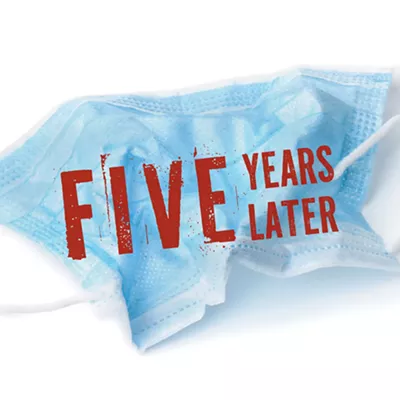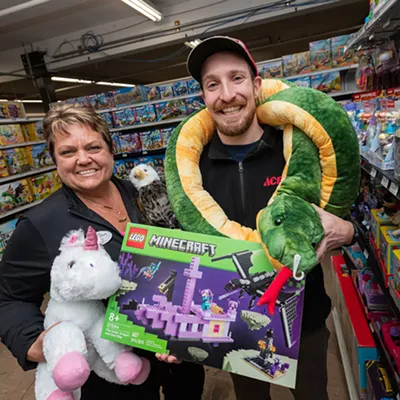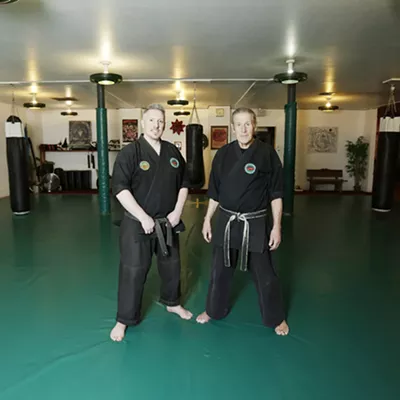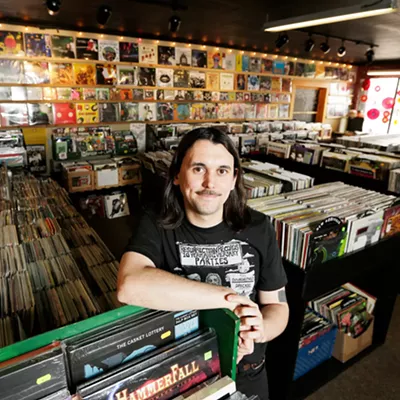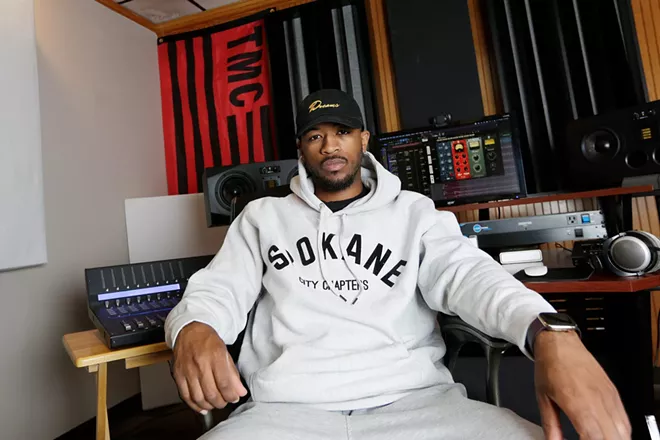
Devonte Pearson was psyched.
It was the start of 2020, and Pearson, a hip-hop artist and sound engineer who goes by T.S the Solution, was gearing up with his business partner James Pakootas for a string of engagements.
"It was going to be our greatest year," he says.
Pearson was especially looking forward to an upcoming gig at Evergreen State College celebrating fashion designers from underrepresented cultures. His performance would provide the catwalk soundtrack.
Then came the lockdowns. The Evergreen event — along with every other gig for the foreseeable future — was canceled to mitigate the spread of COVID-19, and Pearson found himself trying to reconceptualize his creative medium under a radically different set of circumstances. What is live music with no live audience?
"Virtual is just not the same at all. There isn't that person in the crowd that you can engage with and get an immediate response. There's just a room with a sound guy and a lighting guy, so you get a couple of handclaps after a song," he laughs.
But T.S the Solution still welcomed opportunities to appear at virtual shows hosted by Eastern Washington University and Lucky You Lounge. Rather than let downtime go to waste, Pearson and Pakootas rechanneled their energies into a film project called Root.
Pearson also quickly realized that he wasn't alone in enduring these setbacks. Across artistic disciplines, across entire walks of life, everyone was going through the same thing. He started networking even harder within the local music and film scenes, offering and soliciting informal help from fellow artists and venue owners like Lucky You Lounge's Karli and Caleb Ingersoll.
"It was a blessing in disguise. There's a lot of us that say that, even if we say it with a bittersweet taste in our mouths," Pearson says. "Because of the pandemic, we were able to get rid of a lot of distractions, buckle down, and it opened the door for collaboration."
He also began looking outside his usual circles for other resources. He took part in artist residencies in Oregon and Orcas Island and stretched his stipends. He secured a Grant for Artists' Progress Award from the statewide nonprofit Artist Trust. And he reached out to Spokane Arts for COVID relief funding.
"Spokane Arts, Artist Trust and these other programs were like, 'Hey, we're here to help!' And we never knew they were there. It helped build a bridge between the artists and the artist programs and funding," he says. He also took advantage of the educational opportunities they offered on "the business side of the arts" so he could better sustain his work in the long term.
For organizations like the Northwest Museum of Arts and Culture (MAC), the business side of the industry has been an inescapable reality for more than a century. Identifying viable revenue streams and securing funding is an integral part of its operations. Yet those operations are predicated on the assumption that there won't be any huge upsets to the status quo. Many touring exhibitions are scheduled three years in advance.
"We had three separate periods where we were closed, then we reopened, then we had to close again," says Wes Jessup, the MAC's executive director. "We had to delay several exhibitions. We had some really great shows that we weren't able to have up for the amount of time that we had hoped. And that really impacted us."
The popular Pompeii exhibition was the first to close prematurely. The much-anticipated American Impressionism show had to be rescheduled from 2020 to this coming autumn. Jessup and his staff estimated those disruptions and reshuffles cost the MAC more than $1 million in lost revenue. The Paycheck Protection Program (PPP) and Shuttered Venue Operators Grants helped to offset about half of those losses, and the loyal MAC donor base rallied, increasing their combined giving "somewhere on the order of 15 to 20 percent."
The tumult naturally caused ripples in the broader economy. Based on the available tracking data, Jessup estimates that major MAC exhibitions draw about 30 percent of their visitors from beyond Spokane and Kootenai counties. The drop in visitors meant reduced traffic for restaurants and hotels, mainstays of the hospitality industry.
At the same time, that situation served to highlight the interconnectedness of the arts and the regional economy, leading to stronger partnerships between the MAC and local tourism agencies like Visit Spokane. For the new DreamWorks Animation: The Exhibition – Journey from Sketch to Screen (see page 16), they're making a concerted effort to advertise in the Seattle and Portland markets for the first time. Jessup says the DreamWorks show itself is testament to a bolder mindset forged during the pandemic. The MAC outmaneuvered other venues to be the first museum to host it stateside.
"Another positive that came out of [the pandemic] is that we really began looking more closely at our own collections," Jessup says. "That wasn't an uncommon move for a lot of museums. A lot of visual arts organizations began thinking more about their own collections and the assets that they have on hand in their vaults."
The current Awakenings: Traditional Canoes and Calling the Salmon Home exhibition is just one product of that inward focus. The show was developed in conjunction with the United Tribes of the Upper Columbia and features a live onsite canoe carving. In addition, the museum is producing an exhibition of colorful mid-20th-century Mexican masks from its own collection. It will tour nationally in the coming years, which Jessup says is a first for the MAC.
In late summer 2021, at a time of furious cooperation, the MAC also partnered with the new Spokane Ensemble Theatre (SET) to host a live production of Shakespeare's Twelfth Night in its 300-seat outdoor amphitheater. Not unlike the Spokane Shakespeare Society, which got its start around the same time, SET co-founder and artistic director Josephine Keefe saw the pandemic as an urgent driver of fresh ideas and more opportunity in the local theater scene.
"Spokane Ensemble Theatre had been in the making for a number of years. The efforts initially started with the Spokane Theatre Arts Council, or STAC, and the desire to engage the existing theater houses with the changes that we thought they should be considering as they look to the future of their own theater companies," Keefe says.
"Then, lo and behold, a pandemic shuts everything down. It quiets the noise. It leads to many idle artists out of work. It forced a conversation around what people would like to see more of in our theater community. It also started to bring more of a collective body of artists together much faster than [SET co-founder] Rio Alberto and myself had done in the past couple of years."
Fresh off directing an "incredibly challenging" production of Antigone at Gonzaga under strict pandemic protocols during winter 2020-21, Keefe used that stipend to incorporate SET and pay the Twelfth Night actors out of her own pocket. SET has since worked with Birds in the Coast, a new studio space just north of downtown Spokane, for its Spokane Sings Sondheim concert. The organization also recently received $8,000 in Spokane Arts Grant Award (SAGA) funding to return to the MAC amphitheater this summer with a contemporary production of another Shakespeare play, Much Ado About Nothing.
Keefe predicts that the ongoing dialogue and the level of mutual, cross-discipline support that emerged during the pandemic will re-energize the theater community at large. She's of the opinion that will take the form of individual performances and devised pieces "outside of our established houses."
"I'm excited to see where it's going to go," she says, "and I'm hopeful and optimistic that it's going to look like a lot of new work from new directors and young artists that we haven't yet seen before."

Kate Peterson, the director of Get Lit! Programs at Eastern Washington University, shares some of Keefe's hope and optimism for her own endeavors as well as the wider local literary scene. But any positivity in her outlook has been hard won. During the early days of the pandemic, already "running on fumes" due to the previous year's budget cuts, she found herself in tense meetings defending her decision to cancel the landmark literary festival 40 days before it opened.
"There was some talk in the very beginning that, if we cancel, it would be very detrimental to the festival," she says. "I was getting the vibe that [administrative staff] were saying, 'Well, if it goes away now, who's to say it's going to come back?' Once they figured out we were in this for the long haul, then it was a shift back to Get Lit! being a great way to get Eastern out into the community."
Event restrictions and a diminished donor pool prompted Get Lit! to go virtual in 2021, sustained in part by a Literary Arts Emergency Fund grant of $15,000 and a SAGA grant of $5,000.
As she climbs the steep hill to the festival's return to its traditional in-person format next week, Peterson reflects on the past two years as "a great learning experience," even if it was under duress. Virtual events clearly have a place in the festival and will continue to be a part of it in the future. One of her primary goals for 2023, the festival's 25th anniversary year, is to find a large presenting sponsor who will champion Get Lit!.
Echoing Pearson and several other artists, Peterson cites Spokane Arts as a key local support resource — both financial and advisory — throughout the prolonged upheaval. "They were the ones who really stepped up in those dire moments for everybody and tried to help as best they could," she says.
On top of its annual SAGA grants, Spokane Arts helped to distribute $445,000 in arts-related CARES funding allocated by the Spokane City Council. The organization also secured $50,000 for artist relief as part of a private fundraising campaign.
"Everybody is ready to spring out of the gate. There's a lot of exciting energy, and there's a lot of thrust toward collaboration."
Melissa Huggins, executive director at Spokane Arts, says that the impact of those dollars was boosted by the perpetual resourcefulness of the arts community.
"The cultural scene in Spokane is so used to doing a lot with very little," Huggins says. Even her own organization has just three employees.
"A lot of cultural organizations were able to use the pandemic stoppages, as painful as they were, to re-evaluate their programs and services or do facility improvements. Stage Left and Spokane Civic Theatre did a lot of work on their buildings. Terrain is in the process of moving from one gallery to another. So there were some positive updates and changes that couldn't have been done during the normal go, go, go."
While a full post-pandemic recovery could take at least five years for certain parts of the sector, Huggins is encouraged by the recent conversations around "equity and access" she's seeing in the arts community. She also says there's a palpable desire to implement all the creative ideas that emerged over the past two years: "Everybody is ready to spring out of the gate. There's a lot of exciting energy, and there's a lot of thrust toward collaboration."
Pearson can confirm that. He's rekindled much of the enthusiasm he had back in early 2020. Thanks in part to fundraising efforts during the pandemic, he's just opened his Panoramic Dreams recording studio in a fully remodeled computer repair shop on Sprague Avenue. Root is aiming for a mid-2023 release. And even as he works to establish a dedicated hub for the local hip-hop scene, he's imagining the crossover potential.
"Coming out of this pandemic, we've educated ourselves. We're going to start to see people execute all those ideas they have," he says. "And I think we're going to start seeing the rockers, the rappers, the hipsters and the folk musicians collaborate a little bit more." ♦





